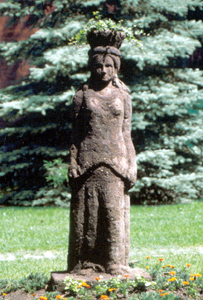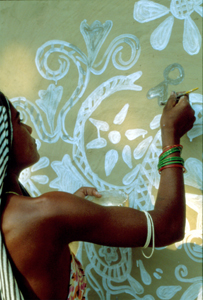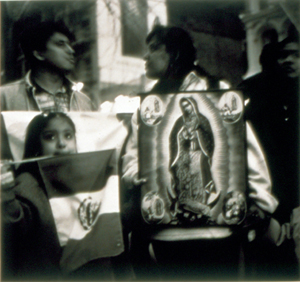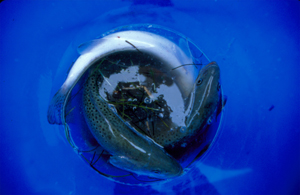








Exhibitions - Spring 2002
February 13 |
Bruce Gundersen and Jerilea Zempel |
February 13 |
Photographs by Benedict J. Fernandez |
| February 19 - April 6 |
St. Lawrence University Festival of the Arts Remapping the Goddess: Global Visions
Shakti: Power of the Divine
Virgin of Guadalupe/LaGuadalupana: |
| April 17 - June 3 |
Tides of Green: South Florida's Natural Diversity Photographs by Matt Bogosian |
| April 17 - June 3 |
Barnes Endowment Annual Juried Student Art Exhibition |
Out of the Woods and into the Fire
Bruce Gundersen and Jerilea Zempel
- January 21 - February 13, 2002
- Related Educational Programs
-
Bruce Gundersen, a significant and early player in New York City’s performance art movement, gradually shifted from that world to live in and create works from the woods. His modern interpretations of Adirondack furniture are often touched with ironic elements central to American art of the last thirty years. Jerilea Zempel, a professor at Fordham University, creates work that is confrontational, humorous, and elegantly simple in the way that science insists on parsimony: she makes her point with the fewest gestures possible. She pokes holes in our moral center, particularly when that center is off-center. Gundersen and Zempel are New York City artists, but both are also Adirondackers. In a special two-day workshop, they invite students and faculty to create a piece in one of the traditional Adirondack-but less recognized and certainly less curated-art forms: ice sculpture. The artists will create two ice towers based on the destruction of the World Trade Center.
-Nathan Farb, exhibition curator

Bruce Gundersen, Bear Break-In, n.d., mixed media
-
Drawing my inspiration from the rich Adirondack design history of 19th-century great camps, lodges, and rustic furniture, I create clocks, cabinets, dressers, and lamps enhanced by dense textural interplays of cured cedar, pinecone scales, and birch barks, and often highlighted with north woods scenes. Combining my experience as a performance artist in the 1970s and my interest in folklore and fairy tales, I often create dioramas that elevate animals to equal status with humans. Bears, wolves, and deer inhabit deserted log cabins, and roam and inspect woodland habitats. Such scenes encourage viewers to enter these miniature worlds and become narrators of imaginary tales.
-Bruce Gundersen

Jerilea Zempel, Caryatis Manouren & The Lady Vanishes, 2000
-
My art education was replete with worshipful attitudes toward art history and its official list of heroic sculptors, all of whom were guys. What better homage could I offer than to build replicas of their masterworks in a kind, biodegradable material and then place these icons out of doors and allow them to slowly melt into the earth, enriching the soil as they disappear? First I did a Brancusi. Then I tackled ancient Greece. Finally, a Henry Moore reclining female nude, one that he cribbed from the Mayans. I built the sculptures from hundreds of manure bricks. Caryatis Manouren is a double homage, first to caryatids, those eternal female figures in Greek architecture who silently and gracefully supported temples atop their heads through the ages. And second, to “black gold,” the organic matter so revered by gardeners, so reviled by others, and so important as a building material in many parts of the world. The Lady Vanishes is dedicated to all the unknown and faceless young models who obsessed the minds of modern geniuses and whose body parts live on forever in art.
-Jerilea Zempel
See www.brucegundersenrusticdesign.com and www.jerileazempel.net for more information about these artists and their work.
Countdown to Eternity
Photographs by Benedict J. Fernandez
- January 21 - February 13, 2002
- Related Educational Programs

before his speech at the United Nations, April 15, 1967
Countdown to Eternity opens at the Richard F. Brush Art Gallery on Martin Luther King, Jr. Day, celebrated this year on Monday, January 21. Comprised of fifty black-and-white photographs of Reverend King and the civil rights movement taken by Benedict J. Fernandez from 1965 to 1968, the exhibition includes such images as King addressing a crowd of 500,000 outside the United Nations on April 15, 1967; King with staff members at the Southern Christian Leadership Conference Headquarters; King at home and at church with his family in Atlanta; and finally, supporters assembled to honor the slain civil rights leader following his assassination in Memphis on April 6, 1968. In addition, photographs of Andrew Young, Julian Bond, Jesse Jackson, Robert Kennedy, and other civil rights activists such as Dick Gregory, Dr. Benjamin Spock, and James Baldwin are included.
Photographs by Benedict J. Fernandez have been published in The New York Times and in Benedict J. Fernandez: Protest Photographs, 1963-1995 (Edition Stemmle, 1996) and In Opposition: Images of American Dissent in the Sixties (Da Capo Press, 1968). He has taught photography at the New School for Social Research in New York and received awards from the John Simon Guggenheim Memorial Foundation and the National Endowment for the Arts.

and Reverend Rice from Pittsburgh, PA, march against the Vietnam War,
Broadway and 50th Street, New York, NY. April 15, 1967
The exhibition is presented at St. Lawrence University in conjunction with Flippin’ the Script: Recognizing Differences, Finding Commonalities, Negotiating Identities, Transforming Communities, a series of activities and events presented through the William and Flora Hewlett Foundation’s Pluralism and Unity Project. Additional funding is provided by the Office of Multicultural Affairs and the First-Year Program. Countdown to Eternity and related educational programs are sponsored by Leica Camera, Inc., Swann Auction Galleries, Ilford Imaging, Dynacolor Graphics, and ARTVision International.
On February 9-10, Benedict J. Fernandez will conduct a special two-day workshop for selected students at St. Lawrence which will include photo shoots, critiques, and preparing work for presentation and exhibition. Please contact the Gallery if you or a student you know would like to participate.
St. Lawrence University Festival of the Arts
Shakti: Power of the Divine Feminine in India
Photographs by Stephen P. Huyler and
Selections from the Georgana Falb Foster Collection
- February 19 - April 6, 2002
- Related Educational Programs

In India, shrines and altars are adorned with representations of devi, a pantheon of female deities who play central roles in Hindu religious practice. On the street, in private homes, businesses, or temples, the sculpted and painted images of devi inspire and guide religious contemplation. These objects may be handmade or mass-produced, intricately worked or elegantly minimal; all vividly illustrate the central role of art in human communication with the spiritual realm.
-
Today, devis (goddesses) are everywhere-in [temples, village and household shrines], poster art, even in advertising, videos, and comic books. Their range of personality types is remarkable: from benign and compassionate figures like Lakshmi (bestower of prosperity and fertility) and Parvati (devoted wife of Shiva and mother of the elephant-headed Ganesha), to militant, protective virgins like Durga (formed from the combined energy of the male gods in order to slay a world-threatening demon in single combat), and of course the ambivalent Kali. To these must be added deified epic heroines like the chaste and self-effacing Sita of the Ramayana and the feisty and vengeful Draupadi of the Mahabharata. Perhaps even more important than these pan-Indian figures are the countless local devis and “little mothers” (matrikas), associated with the very soil of India’s hundreds of thousands of villages. These goddesses are often worshipped in very simple forms: in the flames of oil lamps which manifest feminine energy or shakti, in water-filled clay pots which evoke endless fecundity, and in earthly “self-manifest” (svayambhu) images of gently rounded stone or clay, daubed with vermilion powder and set with all-seeing eyes that facilitate the worshipper’s experience of darshan or visual communion. Though the images may be simple, the theology of goddesses is a complex interweaving of themes of creation and destruction, subordination and dominance, and the local and the universal.
-from “Mother Is In: Seeing and Studying Goddesses in Hindu Tradition”
Philip Lutgendorf, University of Iowa
Professor of Asian Languages and Literature

Durga on Tiger, c. 1980, papier-mâché,
University of Iowa Museum of Art
Comprised of more than 150 drawings, paintings, works of sculpture in bronze, clay, papier-mâché, and wood, as well as elaborately painted textiles and paper scrolls, the Georgana Falb Foster Collection was donated to the University of Iowa in 1998. Nearly 40 objects from the collection and 32 color photographs by Stephen P. Huyler from his exhibition Meeting God: Elements of Hindu Devotion will be on display as part of the 2002 St. Lawrence University Festival of the Arts, Remapping the Goddess: Global Visions, which examines various cultural manifestations of the feminine from contemporary female deities to icons of resistance. In a celebration that includes both men and women, the festival explores the diverse expressions of women’s sexualities, spirit, and power.
-
I consider the purpose of my life to be a bridge between cultures: to open the minds and hearts of the west to those of the east. I am particularly drawn to documenting and interpreting the feminine in India, attempting to portray it in all its facets: its inequalities and disparities and its remarkable strengths. The women of India are phenomenal and worthy of broader recognition. And as an American raised in a patriarchal system that focuses its worship on a male God, I am awed by the pervasive devotion to the Goddess in India. It is She who defines power for both women and men. I believe that I can learn a great deal by being open to this presence. Perhaps our current national and international crises could be greatly ameliorated if we were to listen more deeply to the underlying message of the feminine.
-Stephen P. Huyler
The gallery will be closed March 16-24, 2002 for Spring Break. Special thanks to Victoria Rovine, Curator of the Arts of Africa, Oceania, and the Americas at the University of Iowa Museum of Art. The exhibition and lectures are funded in part by the Brush Art Gallery’s Hap and Betty Barnes Endowment and the Jeanne Scribner Cashin Endowment for Fine Arts.
St. Lawrence University Festival of the Arts
Virgin of Guadalupe/La Guadalupana
Photographs by Mary Teresa Giancoli
- February 19 - April 6, 2002
- Related Educational Programs

in Front of the INS, New York City, 1999, gelatin silver print
- As daylight moves into darkness, I make soft images. This muteness locates the images in a traveling space between New York City and towns in Mexico. In the same way, the families I talk with migrate to thoughts of those left behind, places, and traditions celebrated in Mexico.
I began photographing prayer, rituals, and processions at Our Lady of Guadalupe Church on 14th Street in Manhattan, which has a strong Mexican following. The Virgin of Guadalupe is a dark-skinned goddess who combines elements of the indigenous Aztec goddess Tonantzin with the Spanish Catholic Virgin Mary. In a blue cloak studded with stars, Guadalupe appeared on Tepeyac Hill to the Zapotec Indian Juan Diego in 1531 and made roses grow in this arid region outside of Mexico City. She is the guardian mother of all Mexicans who are indigenous, mestizo, and Spanish. On her feast day, December 12th, children reenact the miracle of Guadalupe and Juan Diego. People give thanks and pray to the Virgin, carry her icon through the streets, and sing for las mañanitas, a dawn celebration accompanied by a mariachi band.
The Virgin of Guadalupe, the most sacred figure, is a symbol of hope, identity, and justice for Mexicans, Chicanos, and Latin Americans who come to the United States for a new life or who have been here for generations. In marches for immigrants’ rights, a banner of the Virgin of Guadalupe represents a people’s struggle in daily life.
I observe how traditions are kept alive and transformed in the urban environment of New York City. The original purpose was to document the growing migration of Mexicans from the Mixtec regions to New York, to remember my Mexican heritage, and to share private and public celebrations.
-Mary Teresa Giancoli
Virgin of Guadalupe/La Guadalupana will be on display as part of the 2002 St. Lawrence University Festival of the Arts, Remapping the Goddess: Global Visions, which examines various cultural manifestations of the feminine from contemporary female deities to icons of resistance. In a celebration that includes both men and women, the festival explores the diverse expressions of women’s sexualities, spirit, and power.
Tides of Green: South Florida's Natural Diversity
Photographs by Matt Bogosian
- April 17 - June 3, 2002

“Exploring the Biodiversity of the Everglades through Science and Photography” was the title of Matt Bogosian’s University Fellows project during the summer of 2001. Matt was awarded the MacKay Fellowship founded by current St. Lawrence trustee, Katy MacKay. With 60 rolls of film, Matt, a double major in biology and studio art, headed to the southwestern tip of Florida to explore its tropical ecosystem. In a few short weeks, he traveled through Big Cypress National Preserve, Fakahatchee Strand State Preserve, the Florida Panther National Wildlife Refuge, and the Everglades National Park.
Although he never encountered any of the near extinct Florida panthers, Matt photographed royal palm trees, cypresses, barred owls, and red-shouldered hawks, to name only a few of the species found in the region. He also documented the eastern lubber grasshopper-big as a mouse but much more colorful, boasting a body of yellows, reds, and greens that may look delectable to those that survive on insects, except for the fact that it’s toxic. For the trip’s grand finale through the Everglades National Park-home of the dolphin, manatee, bull shark, black vulture, and osprey, as well as mangroves, beautiful beaches, and seemingly endless hordes of mosquitoes-Matt climbed aboard a two-person canoe weighed down with a week’s supply of food, water, photo and video equipment, fishing rods, cooking utensils, and camping gear. Along with Justin Patterson, a Coast Guard-approved guide and professional fisherman, Matt embarked upon a 60-mile voyage around Cape Sable in the Gulf of Mexico, camping on beaches and in chickees, or tent platforms built over water. According to Matt, the summer months are the worst for mosquitoes, and from sunset to 10:00 a.m. each day, the two “lubed up” with bug dope, wearing full-body, netted suits to escape the relentless attacks. “There are so many that people call the mosquito the Florida state bird,” Matt said. “Even when we went to bed, we were tormented by their buzzing drone outside our tent.”
Matt described how fishing provided much of their food for the week, catching sea trout and mangrove snappers. “But, the real bait fishing was for sharks. One of the beaches we camped on was known for its amazing surf fishing, and it was one of the few days that we saw people. The guys out there had ten-foot surf rods and stuck fish heads on gaff hooks, which they would cast toward the outgoing currents. They would plant their poles in the sand, open the spools on the reels, and relax on beach chairs drinking beer. ‘Mid sip, with your eyes closed and the sun hot, you’d hear a reel scream to life and a chorus of ‘SHARK ON!’”
-Mark Winterer ‘02
In the fall of 2001, Matt created a limited edition artist’s book of digital photographs that documents the various wildlife he encountered in the Florida Everglades. Visit Matt's Web site at http://www.tidesofgreen.com for more information about the artist and his work.
Barnes Endowment Annual Juried Student Art Exhibition
- April 17 - June 3, 2002
Student artwork in all media, including drawing, painting, photography, sculpture, ceramics, and printmaking, will be presented in this exhibition organized by the Student Art Union and the Department of Fine Arts. The Annual Juried Student Art Exhibition, open to all St. Lawrence University students, is the annual Barnes Endowment Exhibition, with additional funding provided by the Jeanne Scribner Cashin Endowment for Fine Arts.
The Richard F. Brush Art Gallery will be closed March 16-24, 2002 for Spring Break.
We welcome individuals and tours for guided tours of the exhibitions and the University’s permanent collection of nearly 7,000 art objects and artifacts. Many visiting artists and curators are available for class visits by scheduling in advance. Please contact Gallery staff for more information.
Gallery hours Monday-Thursday
Friday and Saturday12-8 p.m.
12-5 p.m.
Catherine Tedford, Director 229-5174 ctedford@stlawu.edu Carole Mathey, Assistant Director 229-5522 cmathey@stlawu.edu